How to Carry Your Axe Properly: Dos and Don’ts
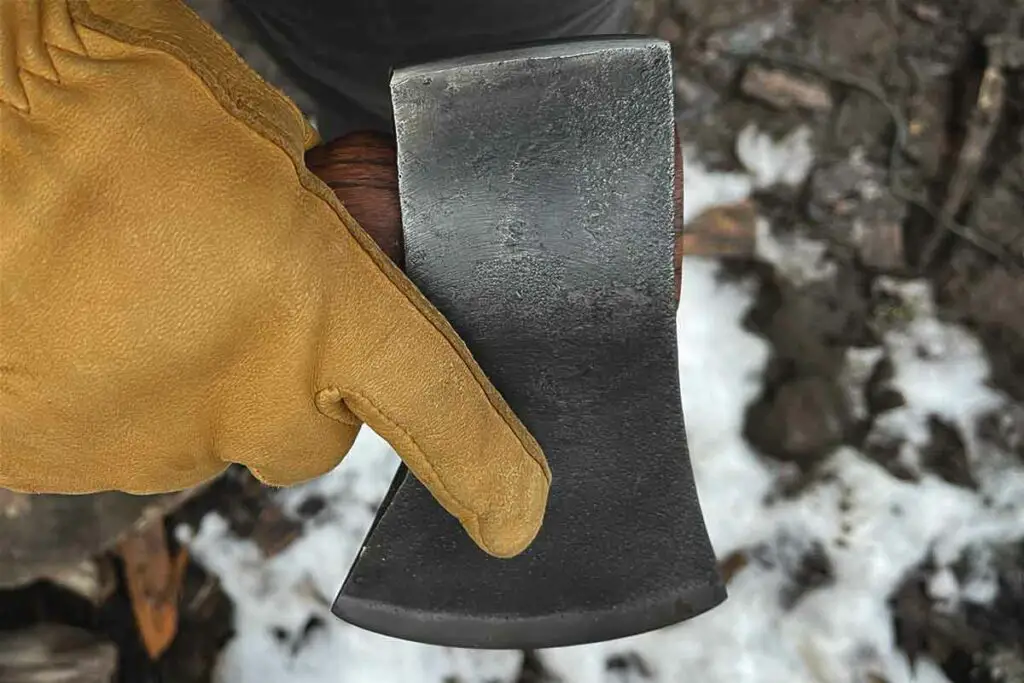
This is just a hobby, but if you buy through a link I may get a commission that supports the site. Thanks!
When carrying an axe it’s important to hold or secure the axe right under the head to keep control of the blade, and use a sheath whenever possible. Also, be mindful to prevent the handle from being caught or bumped to avoid movement. It’s careless mistakes that often lead to accidents and injury.
A lot of injuries happen from laziness and cutting corners by handling an axe unsafely – “just for a minute” or “just this once”.
I’ve tried to cover all that I can, and some of these tips come from hard-learned mistakes – and I have the scars to prove it.
How to Carry an Axe Safely by Hand (4 methods)
If you are just out working on the property or campsite you will need to carry your axe around from task to task – and there are a few good ways to do it safely. Remember, it is always safest to use a sheath.
1. Don’t Put a Lanyard on Your Axe.
If your axe slips, catches a branch or is knocked from your hand – a lanyard will make it swing back toward you. You want to be able to drop your axe in an emergency as it’s often the safest option.
A lanyard hole is added to axe handles to allow for a small string loop to be added to hang your axe up and keep it off the ground.
2. Two-handed Axe Carry is Safest Around the Woodpile
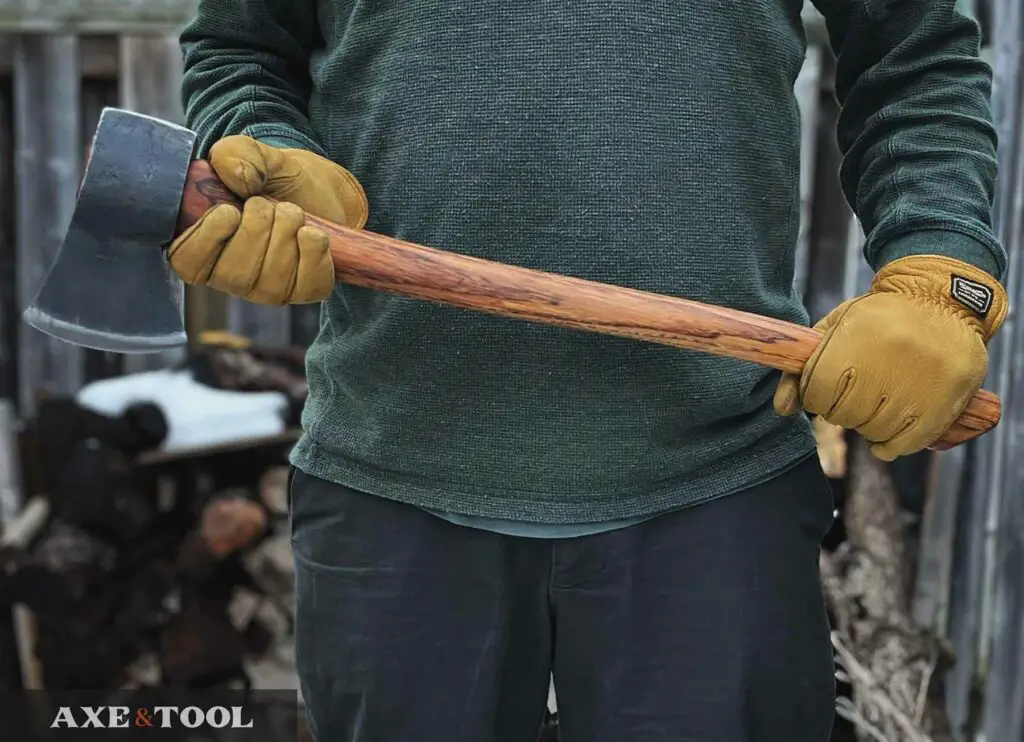
The two-handed hold is the safest for a full-size and boy’s axe, as you have the most control over the axe.
Hold the axe under the head with one hand, and near the bottom of the handle with the other. This keeps it close in front of your body, so it can’t catch or be bumped and prevents the axe from swinging out if you trip.
Should something happen, like a slip or fall – the axe moves with your body, and can’t swing around. Or you can use either hand to move and deal with the axe immediately and safely.
3. One-Handed Axe Carry is Easy to Do Wrong
One-handed carry works the same way for all sizes of axe or hatchet, and itallows you to move easily while keeping a hand free for other tasks.
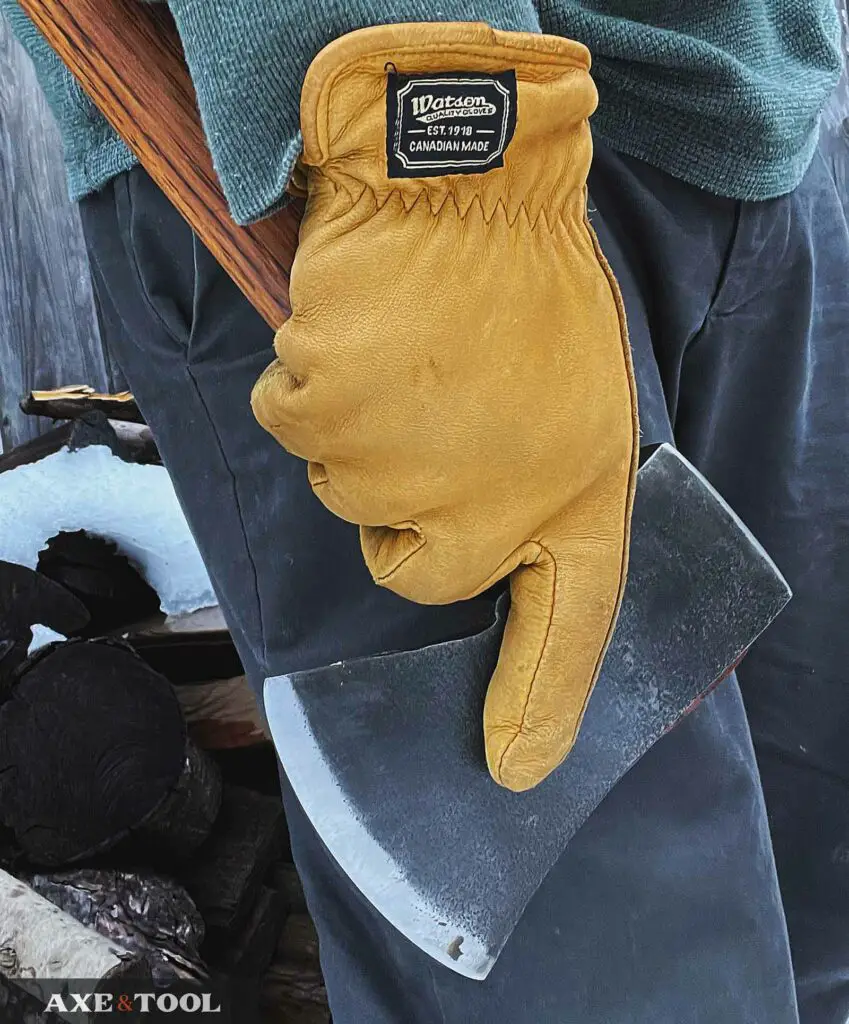
To safely carry an unsheathed axe in one hand, grip right under the head to control the blade. For long-handled axes it’s best to tip the handle up so the axe is upside down, running behind your arm – this stops it from being bumped as you walk.
TIP: I always lay my pointer finger along the side of the axe head. This gives you even more control and a better tactile understanding of where the blade is pointing. You are always pointing to the danger (If you have any firearms experience this should come naturally to you).
Dangers of Carrying an Axe One-Handed
Do not hold an axe or hatchet by the middle or end of the handle. A simple slip or a bump can cause the blade to swing around uncontrolled and hit you or someone else.
I have a scar on my leg, from a time my dog bumped into me (she’s not even big), and the axe I was holding (in this dumb way) cut me.
Carry an axe near the head even with a sheath
I have seen axes cut through their sheaths. So it’s best to hold your axe or hatchet by/near the head even if it has a sheath. I often tuck it into my arm, making movement easier and keeping the axe safe from bumps.
4. Shoulder Carrying an Axe
Carrying an axe over your shoulder is iconic and fine for walking to the worksite – it keeps the head up and away from trouble. It saves your arms the effort if you are walking long distances. I don’t like this method as much as it feels less controlled, but it’s a classic.
How to Carry an Axe With a Pack
I try to carry hatchets and small axes in my pack whenever possible in the outdoors. This keeps my hands free and the axe protected from the elements. The axe or hatchet still must have a sheath.
Many sheaths will have a strap loop or slots built in, but it’s often better to just pack or strap the axe down. I have seen sheaths fail and good axes fall.
5. Packing an Axe in a Bag or Pack Pocket
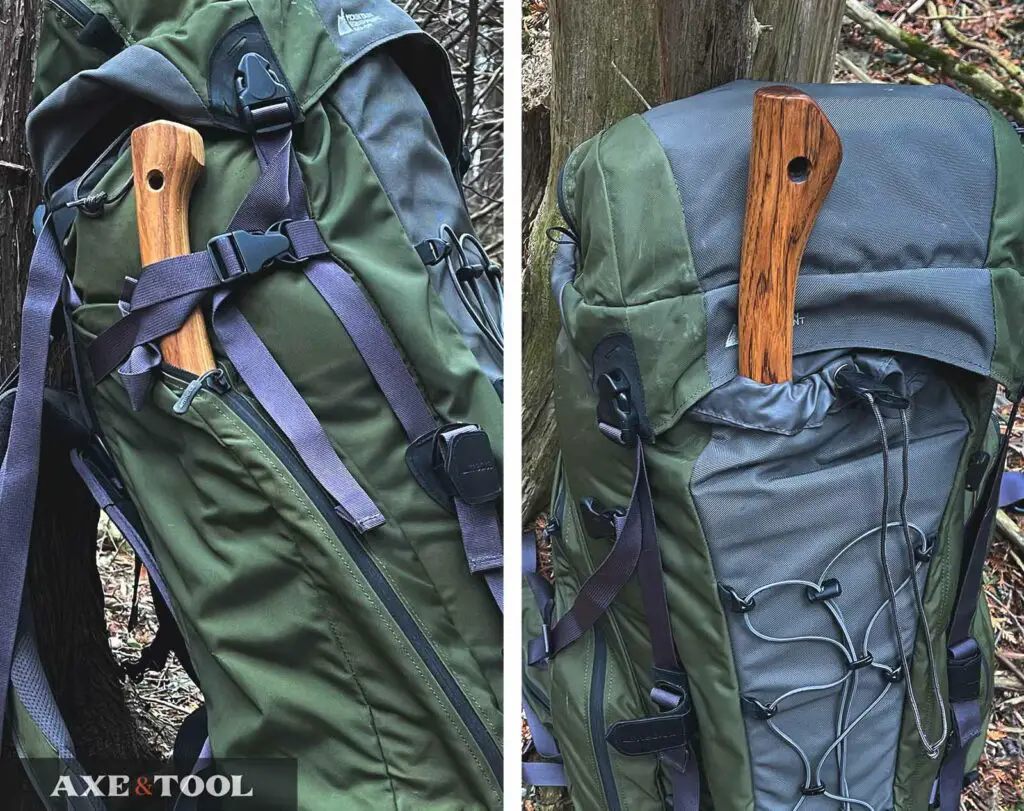
Exterior pockets are my favorite way to store an axe or hatchet in a pack. The head has limited movement, the axe is protected, and it’s quickly accessible.
Axes should be stored head down when carried “loose” in a non-framed bag like a day pack, or in an exterior pocket on a larger bag. The head at the bottom reduces the chance of the axe moving and creates better weight distribution when walking.
If the handle sticks out of the pocket, you should try and pin it with the compression straps. My hiking pack has a pouch for a water reservoir that holds a boy’s axe very well.
6. Packing an Axe inside a Large Hiking Pack
When adding an axe in a full bag, pack it last (or near last), sliding the handle down the back with the head facing to the side. This will make the axe easy to find and slide out as needed and keep you and the axe safe from harm if you fall or drop your pack.
If you pack it too early, it’s likely to get stuck and pull out all kinds of things along the way. Which is just annoying (I have done it many times).
7. Attaching an Axe with Compression Straps

When using pack compression straps, the top strap should go as close to the head as possible to reduce the chance of movement. While also ensuring the bottom of the handle stays above the bottom of the pack (if possible).
If the bottom of the handle is too close to the bottom of the pack, it will hit the ground when you remove your pack and can get damaged.
Tips for using compression straps:
- Wrap the straps once around the handle before tightening it, this will lock the axe in place.
- Connect the axe in two places on the handle to stop the axe from moving or catching on anything as you walk. It can even just get tucked into a side pocket.
- You don’t want to strap your axe to the very back of the pack if you can avoid it. The weight distribution isn’t ideal for hiking, and it can expose the handle to damage.
Carrying a Hatchet (or Axe) on Your Belt
There are a couple of ways you can carry hatchets and even mid-size axes on your belt for quick access.
8. Use an Axe Loop to Keep a Hatchet on Your Side
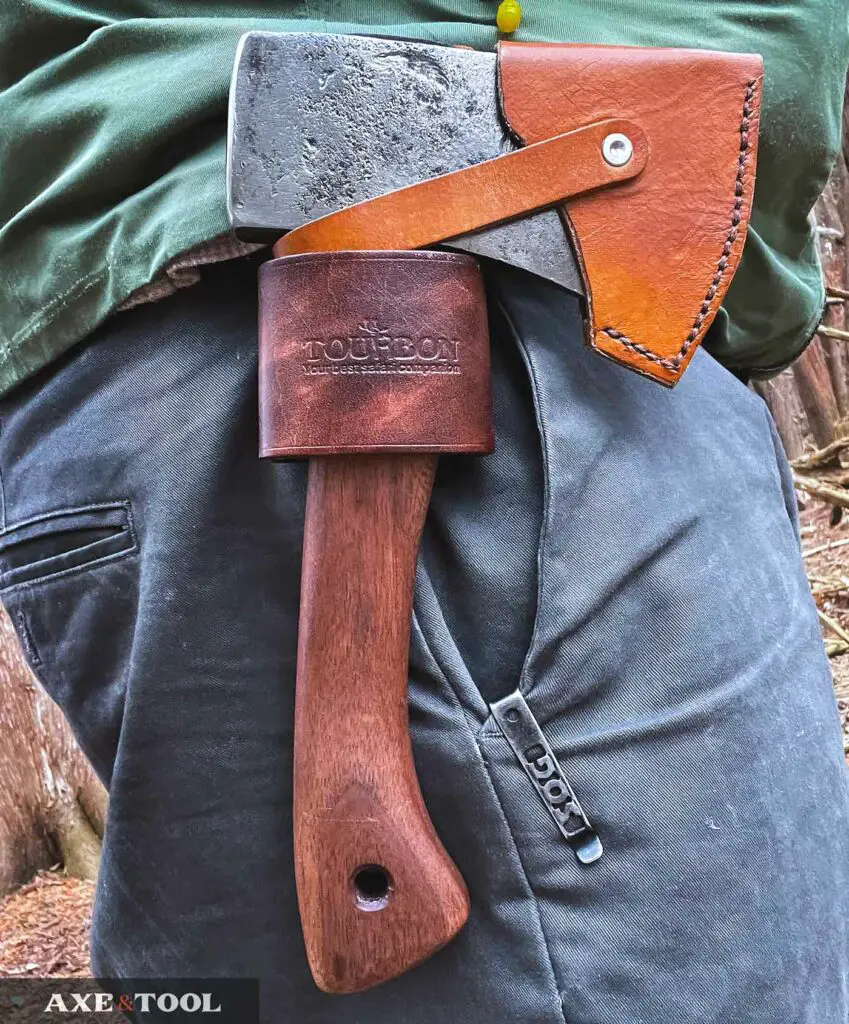
The right way to carry a hatchet or even a small axe on your belt is with a dedicated tool loop.
This simple leather loop attached to your belt allows the hatchet to be grabbed easily and returned one-handed, and the mask can stay on the whole time. It’s also much easier to slide along the belt if you need to make adjustments. This is perfect for bushcraft and light trail work.
They aren’t expensive, but they need to be broken in. The leather comes stiff, so it won’t be a smooth transition at first. And, be sure to check the measurements – hatchets with large palm swells may not fit.
I have the Tourbon leather loop, and I’ve been happy with it.
9. Don’t Attach an Axe Sheath to Your Belt
Attaching the sheath directly to your belt will make it difficult to operate and even dangerous as you try and re-sheath the hatchet at an awkward angle. You can easily cut yourself, or damage other gear.
The only exception (maybe) is the Fiskars sheath – which can be operated one-handed from the side, not the top.
10. Carry a Large Axe on Your Belt With an Arborist / Logger Pouch
There are pouches designed specifically for arborists and loggers that allow you to quickly stow an axe with a full-size head on your belt.
These days professionals use axes mostly for quick limbing and driving wedges to fell a tree rather than actually chopping it down. So they need to be able to transition between a chainsaw and a heavy axe quickly, but it could also be a good option for general trail or property maintenance.
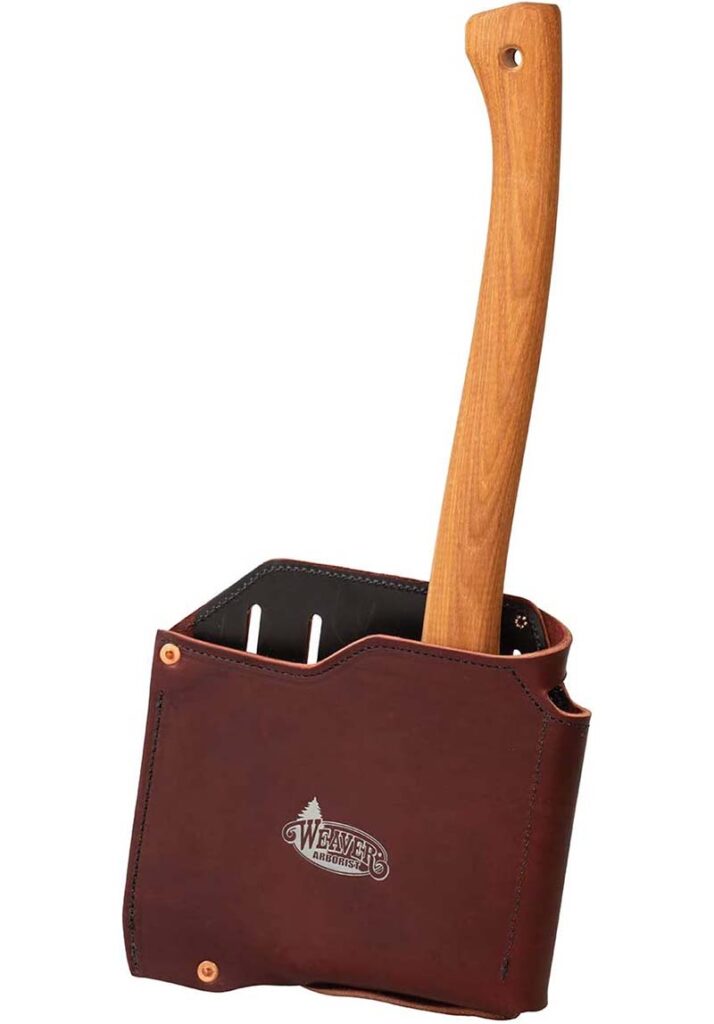
Axe pouches allow you to quickly grab it or drop it back into the pouch while working (or scrambling out of the way of a falling tree). Typically the axes used with these pouches still have shorter handles – 20″24″, with a max 28”.
Weavers pouches are the industry standard.
11. Axe Straps and Slings are an Option
There are sling and harness systems that you can get that can strap an axe to your back. This could be handy walking on your property – but isn’t something I would use in conjunction with a pack.
Council Tool offers a harness system that goes with their woodcraft axe line, but they have never really spoken to me.
Taking an Axe in Your Vehicle

I keep an axe in my vehicle all year, most people don’t need that – but it can be handy sometimes to keep one in the trunk for extended periods depending on the season or region.
12. How to Store an Axe in Your Car
Changing temperatures can wreak havoc on your axe – even if stored in the trunk. Moisture in the air can create condensation, and cause rust on even an unused axe (I found out the hard way).
I have a full article on keeping an axe in your vehicle. But the basics are below:
Short-term storage in a vehicle isn’t a problem, just throw it in the car. But if you are going to have it in there for a while, it’s best to have it in a bag, or even just wrapped in a blanket to reduce the chance of rusting.
Long-term and repeated exposure to changing temperatures can also be hard on an axe, damaging wood handles – so if you plan on keeping one in your vehicle year-round (I do) – choose something with a composite or steel handle.
13. Attaching an Axe to an All-Terrain Vehicle
You can get attachments that hold tool handles, and clamp them to a frame or roof rack like this.
These are very convenient, but follow the same advice from earlier methods. Always keep the axe in a sheath, and either use a composite axe or consider bringing the axe in during the off-season.
About the author:
About the author:
Jim Bell | Site Creator
I’m just a guy who likes axes. I got tired of only finding crap websites, so I set out to build a better one myself.
I’m also on Instagram: @axeandtool

